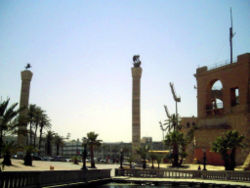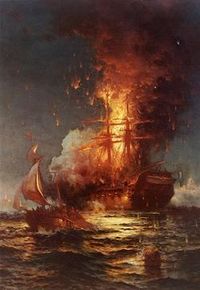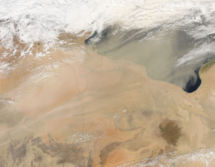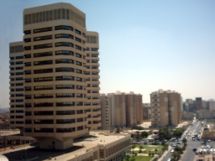Tripoli
2007 Schools Wikipedia Selection. Related subjects: African Geography; Geography of the Middle East
| Tripoli (طرابلس) | |||
| Tripoli Castle and the Green Square | |||
|
|||
| Location of Tripoli within Libya, on the continent of Africa. | |||
| Country | Libya | ||
|---|---|---|---|
| Sha'biyah | Tripoli Sha'biyah | ||
| Head of the People's Committee | Abdullatif Abdulrahman Aldaali | ||
| Area | |||
| - City | 400 km² | ||
| Elevation | 81 m (266 ft) | ||
| Population | |||
| - City (2004) | 1,682,000 | ||
| Time zone | EET ( UTC+2) | ||
| - Summer ( DST) | not observed ( UTC+2) | ||
| Website: http://www.tripoli.info | |||
Tripoli (Arabic: طرابلس Tarābulus) is the capital city of Libya. It has a population of 1.68 million. The city is located in the northwest of the country on the edge of the desert, on a point of rocky land projecting into the Mediterranean Sea and forming a bay. Tripoli was founded in the 7th century BCE by the Phoenicians, who named it Oea. It is located at 32°54'8" North, 13°11'9" East (32.90222, 13.185833).
Tripoli is the largest city, the principal sea port, and the largest commercial and manufacturing centre in Libya. It is also the site of Al-Fateh University. Due to the city's long history, there are many sites of archaeological significance in Tripoli. The climate is typical Mediterranean, with hot, dry summers, cool winters and some modest rainfall.
The city was subjected to an air strike by the United States in 1986, in retaliation for what the US saw as Libya's proven support of terrorism. United Nations sanctions against Libya were lifted in 2003, which is expected to increase traffic through the Port of Tripoli and have a positive impact on the city's economy.
History
Foundation
The city was founded in the 7th century BCE, by the Phoenicians. Tripoli then passed into the hands of the rulers of Cyrenaica (Barca), from whom it was wrested away by the Carthaginians. It next belonged to the Romans, who included it within their province of Africa, and gave it the name of Regio Syrtica. Around the beginning of the 3rd century CE, it became known as the Regio Tripolitana (region of the three cities, namely Oea, Sabrata and Leptis).It was probably raised to the rank of a separate province by Septimius Severus, who was a native of Leptis. Like the rest of North Africa, it was conquered by the Muslims early in the 8th century.
In 1510, it was taken by Don Pedro Navarro, Count of Oliveto for Spain, and, in 1523, it was assigned to the Knights of St. John, who had lately been expelled by the Ottoman Turks from their stronghold in the island of Rhodes. The knights kept it with some trouble until 1551, when they were compelled to surrender.
In 1714, the ruling pasha, Ahmed Karamanli, assumed the title of bey, and asserted a sort of semi-independence of the Sultan, and this order of things continued under the rule of his descendants, accompanied by the brazen piracy and blackmailing until 1835, when the Ottoman Empire ("the Porte") took advantage of an internal struggle.
The Ottoman province (vilayet) of Tripoli (including the dependent sanjak of Cyrenaica) lay along the southern shore of the Mediterranean Sea between Tunisia in the west and Egypt in the east. Besides the city itself, the area included Cyrenaica (the Barca plateau), the chain of oases in the Aujila depression, Fezzan and the oases of Ghadames and Ghat, separated by sandy and stony wastelands.
The Barbary Wars
In the early part of the 19th century, the regency at Tripoli, owing to its piratical practices, was twice involved in war with the United States. In May 1801, the pasha demanded an increase in the tribute ($83,000) which the US government had been paying since 1796 for the protection of their commerce from piracy. The demand was refused, and a naval force was sent from the United States to blockade Tripoli. The First Barbary War dragged on for four years, the Americans in 1803 losing the frigate, Philadelphia, the commander (Captain William Bainbridge) and the whole crew being made prisoners. The most colourful incident in the war was the expedition undertaken by William Eaton with the object of replacing the pasha with an elder brother living in exile, who had promised to accede to all the wishes of the United States. Eaton at the head of a motley crew of 500 US Marines, Greek, Arab and Turkish Mercenaries marched across the desert from Alexandria. Egypt, and with the aid of American ships, succeeded in capturing Derna. Soon afterwards, on June 3, 1805, peace was concluded. The pasha ended his demands and received $60,000 as ransom for the Philadelphia prisoners.
In 1815, in consequence of further outrages, Captains Bainbridge and Stephen Decatur, at the head of an American squadron, again visited Tripoli and forced the pasha to comply with the demands of the United States. See Second Barbary War.
Later history
In 1835, the Turks took advantage of a local civil war to reassert their direct authority. After that date, Tripoli was under the direct control of the Sublime Porte. Rebellions in 1842 and 1844 were unsuccessful. After the occupation of Tunisia by the French (1881), the Turks increased their garrison in Tripoli considerably.
Italy had long claimed that Tripoli fell within its zone of influence and that Italy had the right to preserve order within the state. Under the pretext of protecting its own citizens living in Tripoli from the Turkish Government, it declared war against Turkey on September 29, 1911, and announced its intention of annexing Tripoli. On October 1, 1911, a naval battle was fought at Prevesa, European Turkey, and three Turkish vessels were destroyed. By the Treaty of Lausanne, Italian sovereignty was acknowledged by Turkey, although the Caliph was permitted to exercise religious authority.
Tripoli was controlled by Italy until 1943. After that, it was occupied by British forces until independence in 1951.
Law and Government
The city of Tripoli and its surrounding suburbs all lie within the Tripoli sha'biyah (municipality). In accordance with Libya's Jamahiriya political system, Tripoli comprises of Local People's Congresses where, in theory, the city's population discuss different matters and elect their own people's committee; At present there are 29 Local People's Congresses. In reality, the revolutionary committees severely limit the democratic process by closely supervising committee and congress elections at the branch and municipal levels of governments, Tripoli being no exception. The current head of the Tripoli People's Committee is Abdullatif Abdulrahman Aldaali (عبد اللطيف عبد الرحمن الدالي) & the undersecretary, Mohamed Abudebra (محمد أبودبرة).
Tripoli is sometimes referred to as the de-facto capital of Libya. This is because none of the country's ministries are actually located in the capital. Even the National General People's Congress is held annualy in the city of Surt and not the capital. As part of a radical decentralisation programme undertaken in September 1988, all General People's Committee secretariats ( ministries), except those responsible for foreign liaison ( foreign affairs) and information, were located away from Tripoli. According to diplomatic sources, the former Secretariat for Economy and Trade was moved to Benghazi; the Secretariat for Health to Kufra; and the remainder, excepting one, to Surt, Col. Gaddafi's birthplace. In early 1993 it was announced that the Secretariat for Foreign Liaison and International Co-operation was to be moved to Ras Lanouf.
Geography
Tripoli lies at the western extremity of Libya close to the Tunisian border, on the continent of Africa. Over a thousand kilometeres separate Tripoli from Libya's second largest city, Benghazi. Along the shores of Tripolitania for more than 300 kilometers, coastal oases alternate with sandy areas and lagoons.
The dominant climatic influences in Tripoli, a coastal lowland city, are Mediterranean. The city enjoys warm summers and mild winters with an average July temperature of between 22° and 29° C. In December temperatures have reached as low as 1° C, but the average remains at between 9° and 18° C. The average annual rainfall is less than 400mm, but can be very erratic.
For example, epic floods in 1945 left Tripoli under water for several days, but two years later an unprecedentedly severe drought caused the loss of thousands of head of cattle. Deficiency in rainfall is no doubt reflected in an absence of permanent rivers or streams in Tripoli as well as an absence throughout the entire country. The allocation of limited water is considered of sufficient importance to warrant the existence of the Secretariat of Dams and Water Resources, and damaging a source of water can be penalized by a heavy fine or imprisonment.
The Great Manmade River, a network of pipelines that transport water from the desert to the coastal cities, supplies Tripoli with its water. The grand scheme was initiated by Gaddafi in 1982 and has had a positive impact on the city's inhabitants.
Tripoli is dotted with public spaces, but few fit under the category of large city parks. The Green Square located near the waterfront is scattered with palm trees, the most abundant plant used for landscaping in the city. Tripoli zoo, located south of the city centre, is a large reserve of plants, trees and open green spaces and is the country's biggest zoo.
| Month | Jan | Feb | Mar | Apr | May | Jun | Jul | Aug | Sep | Oct | Nov | Dec | Year |
|---|---|---|---|---|---|---|---|---|---|---|---|---|---|
| Avg high °F (°C) | 63 (17) |
66 (18) |
70 (21) |
78 (25) |
85 (29) |
92 (33) |
95 (35) |
95 (35) |
92 (33) |
84 (28) |
73 (22) |
65 (18) |
(26) |
| Avg low temperature °F (°C) | 44 (6) |
45 (7) |
49 (9) |
54 (12) |
61 (16) |
67 (19) |
69 (20) |
71 (21) |
69 (20) |
63 (17) |
53 (11) |
47 (8) |
(14) |
| Rainfall in. (mm) | 2.7 (69) |
1.6 (41) |
1.0 (25) |
0.5 (13) |
0.2 (5) |
0.1 (3) |
--- (--) |
--- (--) |
0.4 (10) |
1.5 (38) |
2.4 (61) |
3.2 (81) |
(348) |
| Source: Weatherbase | |||||||||||||
Economy
Tripoli is Libya's economic hub. It is the leading centre of banking, finance and communication in the country as well as the leading commercial and manufacturing centre. Many of the country's largest corporations locate their headquarter's home offices in Tripoli as well as the majority of international companies.
Major manufactured goods include processed food, textiles, construction materials, clothing and tobacco products. Since the lifting of sanctions against Libya in 1999 and again in 2003, Tripoli has seen a rise in foreign investment as well as an increase in tourism. Increased traffic has also been recorded in the city's port as well as Libya's main international airport, Tripoli International.
The city is home to the Tripoli International Fair, an international, industrial, agricultural and commercial event located on Omar Muktar Street. One of the active members of the Global Association of the Exhibition Industry (UFI), located in the French capital Paris, the international fair is organised annualy and takes place from the 2nd to the 12th of April. Participation averages around 30 countries as well as more than 2000 companies and organisations.
Since the rise in tourism and influx of foreign businesspeople, there has been an increased demand for hotels in the city. To cater for these increased demands, the Corinthia Bab Africa hotel located in the central business district was constructed in 2003 and is the largest hotel in Libya. Other large hotels include the Bab El Bahr hotel and the Kabir Hotel as well as others.
Sites of Interest
A city opening up to tourism, Tripoli contains many sites of importance. The city's old town is one of the classical sites of the Mediterranean; the walled medina retains much of its old-world ambience. The Assaraya al-Hamra (the Red Castle), a vast palace complex with numerous courtyards, dominates the city skyline and is located on the outskirts of the medina. There are some classical statues and fountains from the Ottoman period scattered around the castle. The Gurgi and Karamanli mosques, with their intricate decorations and tilework, are examples of the artistic skills of local craftsmen.
The basic street plan of the medina was laid down in the Roman period when the walls were constructed as protection against attacks from the interior of Tripolitania. In the 8th century a wall on the sea-facing side of the city was added.
Three gates provided access to the town: Bab Zanata in the west, Bab Hawara in the southeast and Bab Al-Bahr in the north wall. The old city walls are still standing and can be climbed for good views of the city. The Harbour Monument stands at the gates of the old city where there are also a number of restored houses, consulates and a synagogue. The medina is also known for its traditional ware; fine jewellery and clothes can be found in the local markets.
The Jamahiriya Museum, a fine modern facility located in the Red Castle, is Libya's national museum. It houses many artefacts from the country's Roman and Greek periods, including treasures from the World Heritage sites at Leptis Magna and Sabratha, as well as such curiosities as the Volkswagen Beetle car driven by Gadaffi in the 1960s. The only surviving Roman monument in the city, the Arch of Marcus Aurelius, marks the northern end of the medina. Tripoli has some other good museums and archives, including the National Archives, the Government Library, the Ethnographic Museum, the Archaeological Museum, the Epigraphy Museum and the Islamic Museum.
Colleges and Universities
The largest university in Tripoli, Al Fateh Univeristy, is a public university providing free education to the city's inhabitants. Private universities and colleges have begun to crop up in the last few years.
Universities in Tripoli include:
- Al Fateh Univeristy - The largest and most important university in Tripoli
- Tripoli University
- Informatics Tripoli
Sports
Football is the most popular sport in the Libyan capital. Tripoli is home to two of the most prominent football clubs in Libya, Al Ahly (Tripoli) and Al Ittihad.
The main sports clubs based in Tripoli:
- Al Ahly (Tripoli)
- Al Ittihad
- Al Madina
- Al Shat
- Al Wahda
Town twinning
 Belgrade, Serbia
Belgrade, Serbia Belo Horizonte, Brazil (since 2003)
Belo Horizonte, Brazil (since 2003) Madrid, Spain
Madrid, Spain Sarajevo, Bosnia and Herzegovina (since 1976)
Sarajevo, Bosnia and Herzegovina (since 1976)







